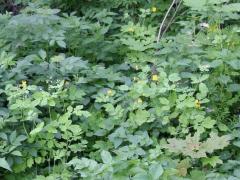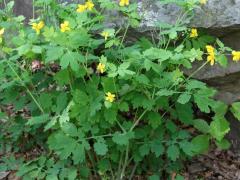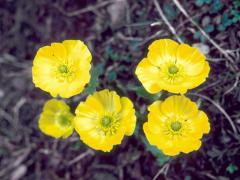Invasive Species: Chelidonium majus, Greater Celandine
Greater celandine is an invasive perennial native to Europe and the Mediterranean region. It can reach from 1 to 4 ft. (0.3 to 1.2 m) in height. The leaves are up to 14 in. (35 cm) long and are deeply dissected. Flowering occurs from May to June. Flowers have four yellow petals, each 0.4 in. (1 cm) long, and two sepals. The fruit are linear capsules 0.8 to 2 in. (2 to 5 cm) long. Greater celandine is poisonous to humans and occurs in moist to dry woods, thickets, roadsides, and waste grounds.
What are invasive species and why should we be concerned about them?
Taxonomy: Scientific and Common Names for This Species
Papaverales > Papaveraceae > Chelidonium majus L.
Chelidonium majus – USDA PLANTS Profile
Distribution Maps
Greater celandine – The reported distribution of this invasive species across the United States (Source: Invasive Plant Atlas of the United States)
Up-to-the-minute distribution maps and why they are important
Reporting This Invasive Species
What is the best way and place to report the occurrence of an invasive species?
How to report an invasive species sighting to EDDMapS – Early Detection & Distribution Mapping System
EDDMapS – Report an invasive species to EDDMapS.
Cooperative Extension Offices – Find your local Cooperative Extension office on this map provided by USDA.
How to Identify
This invasive species can be identified by looking for the characteristics described in the paragraphs that follow.
Plant
Greater celandine is a perennial that can reach from 1 to 4 ft. (0.3 to 1.2 m) in height.
 |
 |
| Stacey Leicht, University of Connecticut, bugwood.org | Robert Videki, Doronicum Kft., bugwood.org |
Foliage
The leaves are up to 14 in. (35 cm) long and are deeply dissected.
 |
 |
| Robert Videki, Doronicum Kft., bugwood.org | Robert Videki, Doronicum Kft., bugwood.org |
Flower
Flowering occurs from May to June. Flowers have four yellow petals, each 0.4 in. (1 cm) long, and two sepals.
 |
 |
| Leslie J. Mehrhoff, University of Connecticut, bugwood.org | Stacey Leicht, University of Connecticut, bugwood.org |
Fruit
The fruit are linear capsules that are 0.8 to 2 in. (2 to 5 cm) long.
 |
 |
| Stacey Leicht, University of Connecticut, bugwood.org | Stacey Leicht, University of Connecticut, bugwood.org |
Native Species That Can Resemble Greater Celandine
Ranunculus macauleyi, Rocky Mountain buttercup – Bugwood.org
 |
 |
| Dave Powell, USDA Forest Service, bugwood.org | Dave Powell, USDA Forest Service, bugwood.org |
Ranunculus sulphureus, sulphur buttercup – Bugwood.org
 |
 |
| Mary Ellen (Mel) Harte, bugwood.org | Mary Ellen (Mel) Harte, bugwood.org |
Additional Images for Greater Celandine
Greater celandine – Images at Invasive.org
Learning Resources for Greater Celandine
Additional Information, Biology, Control and Management Resources
Control and management recommendations vary according to individual circumstances. Location, habitat, weather, and a variety of other conditions are factors that help determine the best treatment choice. To find the safest and most effective treatment for your situation, consult your state’s land-grant institution. If you will use chemicals as part of the control process, always refer to the product label.
United States Land-Grant University System – Find your land-grant university’s college of agriculture, Cooperative Extension office, or other related partner on this map provided by USDA.
Fact Sheet – Pennsylvania Dept. of Conservation and Natural Resources
Home Grown Facts – Cornell Cooperative Extension of Oneida County
Invasive Plant Atlas of New England – University of Connecticut
